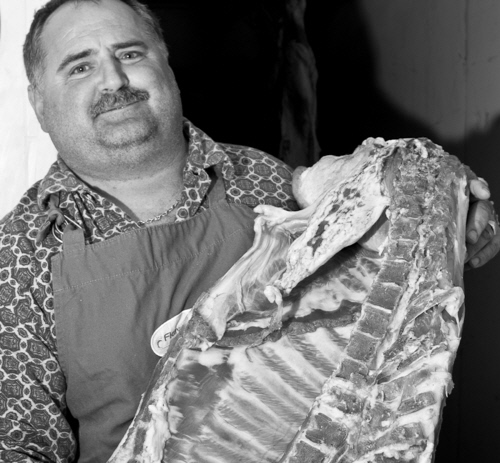Before we could go to the Istrate farm, we had to go to a farmer’s market in Brasov in order to give a ride to the mistress of the house, Mrs Marcela Istrate, back home.
Having passed another potholed road, we arrived at a farm with sheep, cows, chickens and pigs surrounded by meadows and hills. Unfortunately, their sheepfold was 2 hours walk away leading to that we just stayed at the farm.
After being served a wide selection of their home-made cheeses, Mr Ioan Istrate invited us to join him slaughtering a calf which had been butchered the day before. Having just entered a cool room, he went inside their refrigerated room and came back with what was left of the calf. Then, he started the business of slaughtering by means of a knife and an ax. Having succeeded in removing bones and some meat he didn’t want, he salted the meat and put it back again in the refrigerated room. The meat and bones he had removed would be turned into sausages another day.
After having finished the meat, we were treated to how to make cheese. Since the cheese mass was ready for separation at our arrival, he started scooping up the cheese mass by means of a bucket and pouring its contents into a tank which he had covered with a porous cloth. Always pouring the cheese in a different area of the tank, he obtained a somewhat level surface in the end. Having transferred all the cheese mass to the tank, he used a knife to divide the cheese mass in a grid, one vertical or horizontal line at a time. Afterwards, he tied up the cloth, put a wooden lid on top of it, then he put some heavy weights on the lid in order to press out the whey, which started flowing out of an opening in the tank into another container below.
We were also shown the room where they were smoking some of their cheeses. It was simply done by lighting a fire below a bowl filled with whey, from which they would extract ricotta, while the smoke would pass the cheeses stored on a shelf in the same room.
Our next demonstration was how he made cheese in sheep’s stomachs and in fir-tree bark cylinders. Starting with a porous cheese, he cut it in pieces with a knife and put the pieces in a box. When all the cheese had been cut up, he put the pieces in a meat grinder and turned on power. It was like watching someone grinding meat, just that the colour of the stuff being ground was yellow. After having ground the whole cheese, he mixed the shapes into fist-sized clumps. Having finished this, he started making cylinders of fir-tree bark.
The fir-tree bark looked like a piece of leather having more or less the same colour. He started with cutting it into a rectangle, then he used a needle and a narrow ribbon used for wrapping Christmas gifts. Having joined the two long sides of the rectangle by means of sewing, making a cylinder, he started sewing a lid to one of its ends. Having finished, he used a knife in order to cut away the superfluous bark. Then, he started filling the cylinder with the cheese, compressing it as much as he could and filling it up to the top. Finally, he put a lid on the top, joining it to the cylinder by means of sewing again.
Having made a fir-tree bark cylinder, he started filling up a sheep’s stomach with the same cheese. Having put as much cheese as possible into it, he closed the opening by putting a circular-shaped piece of fir-tree bark in the opening and closing it by sewing.
Making a search on the internet for cheese in fir-tree bark, I found that it may date back to the time when the Romans invaded what is now called Romania. The locals fled to the mountains bringing their sheep with them. Having abundant fir-tree forests, they learned how to preserve sheep’s cheese in fir-tree bark, making the cheese edible for a much longer time than by just storing it without protection.
Anyway, having been shown so much, it was time to have a look outside. In addition to pigs sleeping in mud and free-ranging chickens, a large flock of cows were grazing on a meadow near the farm, being looked after by a cowherd. Before we entered the room for watching preparation of meat and cheese, there was a large flock of sheep in the shade of a giant tree. When we came out again, the sheep had disappeared, possibly ascending some of the beautiful hills surrounding the farm.

